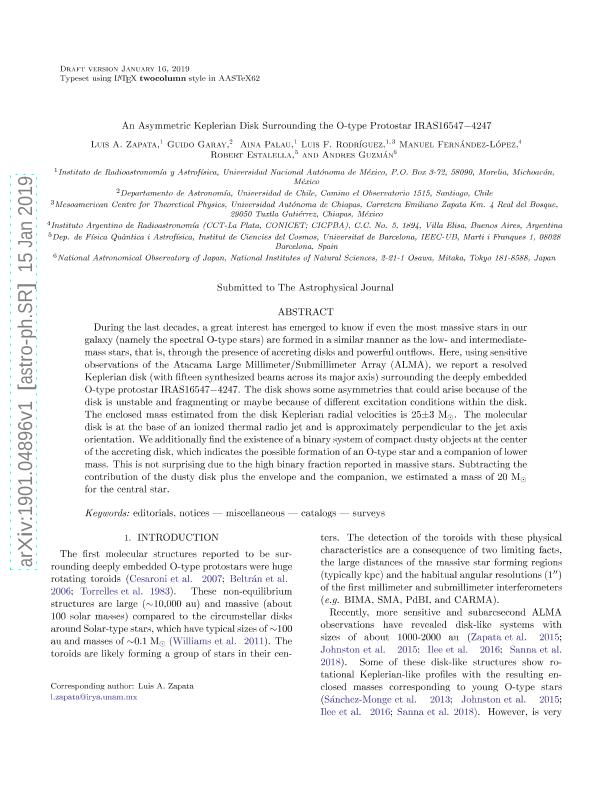Mostrar el registro sencillo del ítem
dc.contributor.author
Zapata, Luis A.
dc.contributor.author
Garay, Guido
dc.contributor.author
Palau, Aina
dc.contributor.author
Rodríguez, Luis F.
dc.contributor.author
Fernandez Lopez, Manuel

dc.contributor.author
Estalella, Robert
dc.contributor.author
Guzmán, Andres
dc.date.available
2020-05-29T14:56:06Z
dc.date.issued
2019-02
dc.identifier.citation
Zapata, Luis A.; Garay, Guido; Palau, Aina; Rodríguez, Luis F.; Fernandez Lopez, Manuel; et al.; An Asymmetric Keplerian Disk Surrounding the O-type Protostar IRAS 16547-4247; IOP Publishing; Astrophysical Journal; 872; 2; 2-2019; 1-10
dc.identifier.issn
0004-637X
dc.identifier.uri
http://hdl.handle.net/11336/106243
dc.description.abstract
For the past few decades, there has been great interest in determining if even the most massive stars in our galaxy (namely the spectral O-type stars) are formed in a similar manner as the low- and intermediate-mass stars, that is, through the presence of accreting disks and powerful outflows. Here, using sensitive observations of the Atacama Large Millimeter/Submillimeter Array, we report a resolved Keplerian disk (with 15 synthesized beams across its major axis) surrounding the deeply embedded O-type protostar IRAS 16547-4247. The disk shows some asymmetries that could arise because the disk is unstable and fragmenting or because of different excitation conditions within the disk. The enclosed mass estimated from the disk Keplerian radial velocities is 25 -3 M . The molecular disk is at the base of an ionized thermal radio jet and is approximately perpendicular to the jet axis orientation. We additionally find the existence of a binary system of compact dusty objects at the center of the accreting disk, which indicates the possible formation of an O-type star and a companion of lower mass. This is not surprising due to the high binary fraction reported in massive stars. Subtracting the contribution of the dusty disk plus the envelope and the companion, we estimated a mass of 20 M for the central star.
dc.format
application/pdf
dc.language.iso
eng
dc.publisher
IOP Publishing

dc.rights
info:eu-repo/semantics/openAccess
dc.rights.uri
https://creativecommons.org/licenses/by-nc-sa/2.5/ar/
dc.subject
FORMATION
dc.subject
STARS
dc.subject.classification
Astronomía

dc.subject.classification
Ciencias Físicas

dc.subject.classification
CIENCIAS NATURALES Y EXACTAS

dc.title
An Asymmetric Keplerian Disk Surrounding the O-type Protostar IRAS 16547-4247
dc.type
info:eu-repo/semantics/article
dc.type
info:ar-repo/semantics/artículo
dc.type
info:eu-repo/semantics/publishedVersion
dc.date.updated
2020-05-19T19:02:47Z
dc.journal.volume
872
dc.journal.number
2
dc.journal.pagination
1-10
dc.journal.pais
Reino Unido

dc.journal.ciudad
Londres
dc.description.fil
Fil: Zapata, Luis A.. Universidad Nacional Autónoma de México; México
dc.description.fil
Fil: Garay, Guido. Universidad de Chile; Chile
dc.description.fil
Fil: Palau, Aina. Universidad Nacional Autónoma de México; México
dc.description.fil
Fil: Rodríguez, Luis F.. Universidad Nacional Autónoma de México; México
dc.description.fil
Fil: Fernandez Lopez, Manuel. Provincia de Buenos Aires. Gobernación. Comisión de Investigaciones Científicas. Instituto Argentino de Radioastronomía. Consejo Nacional de Investigaciones Científicas y Técnicas. Centro Científico Tecnológico Conicet - La Plata. Instituto Argentino de Radioastronomía; Argentina
dc.description.fil
Fil: Estalella, Robert. Universidad de Barcelona; España
dc.description.fil
Fil: Guzmán, Andres. National Astronomical Observatory of Japan; Japón
dc.journal.title
Astrophysical Journal

dc.relation.alternativeid
info:eu-repo/semantics/altIdentifier/doi/http://dx.doi.org/10.3847/1538-4357/aafedf
dc.relation.alternativeid
info:eu-repo/semantics/altIdentifier/url/https://iopscience.iop.org/article/10.3847/1538-4357/aafedf
Archivos asociados
